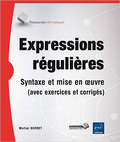GNU/Linux man pages
Livre :
Expressions régulières,
Syntaxe et mise en oeuvre :


Unix |
Unix v7 |
|
 |
dd(1) |
 |
dd − convert and copy a file
dd [option=value] ...
Dd copies the specified input file to the specified output with possible conversions. The standard input and output are used by default. The input and output block size may be specified to take advantage of raw physical I/O.
|
option |
values | ||
|
if= |
input file name; standard input is default | ||
|
of= |
output file name; standard output is default | ||
|
ibs=n |
input block size n bytes (default 512) | ||
|
obs=n |
output block size (default 512) | ||
|
bs=n |
set both input and output block size, superseding ibs and obs; also, if no conversion is specified, it is particularly efficient since no copy need be done | ||
|
cbs=n |
conversion buffer size | ||
|
skip=n |
skip n input records before starting copy | ||
|
files=n |
copy n files from (tape) input | ||
|
seek=n |
seek n records from beginning of output file before copying | ||
|
count=n |
copy only n input records | ||
|
conv=ascii |
convert EBCDIC to ASCII | ||
|
ebcdic |
convert ASCII to EBCDIC | ||
|
ibm |
slightly different map of ASCII to EBCDIC | ||
|
lcase |
map alphabetics to lower case | ||
|
ucase |
map alphabetics to upper case | ||
|
swab |
swap every pair of bytes | ||
|
noerror |
do not stop processing on an error | ||
|
sync |
pad every input record to ibs | ||
|
... , ... |
several comma-separated conversions |
Where sizes are specified, a number of bytes is expected. A number may end with k, b or w to specify multiplication by 1024, 512, or 2 respectively; a pair of numbers may be separated by x to indicate a product.
Cbs is used only if ascii or ebcdic conversion is specified. In the former case cbs characters are placed into the conversion buffer, converted to ASCII, and trailing blanks trimmed and new-line added before sending the line to the output. In the latter case ASCII characters are read into the conversion buffer, converted to EBCDIC, and blanks added to make up an output record of size cbs.
After completion, dd reports the number of whole and partial input and output blocks.
For example, to read an EBCDIC tape blocked ten 80-byte EBCDIC card images per record into the ASCII file x:
|
dd if=/dev/rmt0 of=x ibs=800 cbs=80 conv=ascii,lcase |
Note the use of raw magtape. Dd is especially suited to I/O on the raw physical devices because it allows reading and writing in arbitrary record sizes.
To skip over a file before copying from magnetic tape do (dd of=/dev/null; dd of=x) </dev/rmt0
cp(1), tr(1)
f+p records in(out): numbers of full and partial records read(written)
The ASCII/EBCDIC conversion tables are taken from the 256 character standard in the CACM Nov, 1968. The ’ibm’ conversion, while less blessed as a standard, corresponds better to certain IBM print train conventions. There is no universal solution.
Newlines are inserted only on conversion to ASCII; padding is done only on conversion to EBCDIC. These should be separate options.
 |
dd(1) |  |